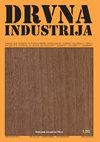T型螺母在各种家具材料中的拔出阻力
IF 0.8
4区 农林科学
Q4 MATERIALS SCIENCE, PAPER & WOOD
引用次数: 2
摘要
T型螺母在工厂安装在准备组装的家具部件的孔中。存在t型螺母在运输或储存过程中自发脱落并丢失的风险;在组装过程中,t形螺母也可以被推入不可接近的空间。这些复杂情况会使家具组装变得不可能。因此,必须有足够的力将t形螺母固定在孔中。本文介绍了五种家具材料(软木、定向刨花板、胶合板和刨花板的两种变体)中t形螺母的受力测试结果。将带有四个尖头的M6 t形螺母安装在预先钻出的8 mm孔中。用通用试验机测量了t形螺母的拔出阻力。根据t型螺母脱落的风险,测试材料可分为三组:软木和胶合板——低风险,F=1113.2-1158.0 N;OSB和刨花板——中等风险,F=592.3-645.5N,带衬垫的刨花板——高风险,F=645.5N。结果表明,抗拔性与木材材料的密度无关,并且随着木材材料加工的程度而降低——材料加工得越少,t型螺母的抗拔性就越大。本文章由计算机程序翻译,如有差异,请以英文原文为准。
Withdrawal Resistance of T-Nuts in Various Furniture Materials
T-nuts are factory installed in the holes of the ready-to-assemble furniture components. There is a risk that the t-nut spontaneously falls out during transport or storage and get lost; the t-nut can also be pushed into inaccessible spaces during assembly. These complications can make furniture assembly impossible. For this reason, sufficient force to hold the t-nut in the hole is essential. The article presents the test results of the forces holding the t-nuts in five furniture materials (softwood, Oriented Strand Board, plywood, and particleboard in two variants). The M6 t-nuts with four prongs were installed in predrilled 8 mm holes. The resistance to withdrawal of the t-nuts was measured with a universal testing machine. The tested materials could be divided into three groups in terms of the risk of the t-nut falling out: softwood and plywood – low risk, F = 1113.2-1158.0 N; OSB and particleboard – moderate risk, F = 592.3-645.5 N, particleboard with a pad – high risk, F = 645.5 N. The results show that the withdrawal resistance is not correlated with the density of the wood material, and that it decreased with the degree of wood material processing – the less processed the material, the greater the resistance to withdrawal of the t-nuts.
求助全文
通过发布文献求助,成功后即可免费获取论文全文。
去求助
来源期刊

Drvna Industrija
MATERIALS SCIENCE, PAPER & WOOD-
CiteScore
1.80
自引率
9.10%
发文量
32
审稿时长
>12 weeks
期刊介绍:
"Drvna industrija" ("Wood Industry") journal publishes original scientific and review papers, short notes, professional papers, conference papers, reports, professional information, bibliographical and survey articles and general notes relating to the forestry exploitation, biology, chemistry, physics and technology of wood, pulp and paper and wood components, including production, management and marketing aspects in the woodworking industry.
 求助内容:
求助内容: 应助结果提醒方式:
应助结果提醒方式:


